SUMMARY CMI
TARGIN® modified release tablets
Consumer Medicine Information (CMI) summary
The full CMI on the next page has more details. If you are worried about using this medicine, speak to your doctor or pharmacist.
WARNING: Important safety information is provided in a boxed warning in the full CMI. Read before using this medicine.
1. Why am I using TARGIN tablets?
TARGIN tablets contain the active ingredients oxycodone hydrochloride and naloxone hydrochloride. TARGIN tablets are used to relieve severe pain when other forms of treatment have failed or are otherwise inappropriate to provide sufficient management of pain. The naloxone in TARGIN tablets will help prevent and treat opioid-induced constipation. TARGIN tablets are also used to relieve the symptoms of severe to very severe restless legs syndrome in people who can't be treated with dopamine medicines.
For more information, see Section 1. Why am I using TARGIN tablets? in the full CMI.
2. What should I know before I use TARGIN tablets?
Do not use if you have ever had an allergic reaction to oxycodone, naloxone or any of the ingredients listed at the end of the CMI.
Talk to your doctor if you have any other medical conditions, take any other medicines, or are pregnant or plan to become pregnant or are breastfeeding.
For more information, see Section 2. What should I know before I use TARGIN tablets? in the full CMI.
3. What if I am taking other medicines?
Some medicines may interfere with TARGIN tablets and affect how it works.
A list of these medicines is in Section 3. What if I am taking other medicines? in the full CMI.
4. How do I use TARGIN tablets?
- Your doctor will tell you exactly how much to take.
- Follow the instructions given to you by your doctor or your pharmacist.
- You must only take TARGIN tablets by mouth.
More instructions can be found in Section 4. How do I use TARGIN tablets? in the full CMI.
5. What should I know while using TARGIN tablets?
| Things you should do |
|
| Things you should not do |
|
| Driving or using machines |
|
| Drinking alcohol |
|
| Looking after your medicine |
|
For more information, see Section 5. What should I know while using TARGIN tablets? in the full CMI.
6. Are there any side effects?
TARGIN tablets may cause nausea, vomiting, dizziness, drowsiness and be habit forming if taken frequently or over long periods.
For more information, including what to do if you have any side effects, see Section 6. Are there any side effects? in the full CMI.
WARNING:
Limitations of use
TARGIN tablets should only be used when your doctor decides that other treatment options are not able to effectively manage your pain or you cannot tolerate them.
Hazardous and harmful use
TARGIN tablets poses risks of abuse, misuse and addiction which can lead to overdose and death. Your doctor will monitor you regularly during treatment.
Life threatening respiratory depression
TARGIN tablets can cause life-threatening or fatal breathing problems (slow, shallow, unusual or no breathing) even when used as recommended. These problems can occur at any time during use, but the risk is higher when first starting TARGIN tablets and after a dose increase, if you are older, or have an existing problem with your lungs. Your doctor will monitor you and change the dose as appropriate.
Use of other medicines while using TARGIN tablets
Using TARGIN with other medicines that can make you feel drowsy such as sleeping tablets (e.g. benzodiazepines), other pain relievers, antihistamines, antidepressants, antipsychotics, gabapentinoids (e.g. gabapentin and pregabalin), cannabis and alcohol may result in severe drowsiness, decreased awareness, breathing problems, coma and death. Your doctor will minimise the dose and duration of use; and monitor you for signs and symptoms of breathing difficulties and sedation. You must not drink alcohol while using TARGIN.
FULL CMI
TARGIN® modified release tablets
Active ingredient(s): oxycodone hydrochloride and naloxone hydrochloride
Consumer Medicine Information (CMI)
This leaflet provides important information about using TARGIN tablets. You should also speak to your doctor or pharmacist if you would like further information or if you have any concerns or questions about using TARGIN tablets.
Where to find information in this leaflet:
1. Why am I using TARGIN tablets?
2. What should I know before I use TARGIN tablets?
3. What if I am taking other medicines?
4. How do I use TARGIN tablets?
5. What should I know while using TARGIN tablets?
6. Are there any side effects?
7. Product details
1. Why am I using TARGIN tablets?
TARGIN tablets contain the active ingredients oxycodone hydrochloride and naloxone hydrochloride. Oxycodone belongs to a group of medicines called opioid analgesics. Naloxone is a medicine which, when taken orally, can block some of the effects of opioids in the gut, such as constipation.
Pain relief:
TARGIN tablets are used to relieve severe pain when other forms of treatment have failed or are otherwise inappropriate to provide sufficient management of pain. The naloxone in TARGIN tablets will help prevent and treat opioid-induced constipation.
Restless legs syndrome:
TARGIN tablets are also used to relieve the symptoms of severe to very severe restless legs syndrome in people who can't be treated with dopamine medicines. People with restless legs syndrome have unpleasant sensations in their limbs. This can start as soon as they sit or lie down and is only relieved by an irresistible urge to move the legs, sometimes the arms and other parts of the body. It makes sitting still and sleeping very difficult.
TARGIN tablets helps to relieve the unpleasant sensations and so reduces the urge to move the limbs.
Your doctor, however, may prescribe it for another purpose.
Ask your doctor if you have any questions about why it has been prescribed for you.
This medicine is only available with a doctor's prescription.
2. What should I know before I use TARGIN tablets?
Warnings
Long-term use of TARGIN tablets may affect your fertility. If you have any concerns about taking this medicine, ask your doctor.
Be aware that TARGIN tablets may produce a positive result in sports agency drug testing.
Do not use TARGIN tablets if you:
- are allergic to oxycodone hydrochloride and naloxone hydrochloride, opioid painkillers, or any of the ingredients listed at the end of this leaflet. Always check the ingredients to make sure you can use this medicine.
- have any breathing problems such as acute asthma, respiratory depression (breathing slows or weakens) or other obstructive airways disease
- are severely drowsy or have a reduced level of consciousness
- have heart problems due to long-term lung disease
- have irregular heart beats or changes in the way the heart beats
- have just consumed and/or regularly consume large amounts of alcohol or have confusion and shaking due to alcohol withdrawal
- suffer from convulsions, fits or seizures
- have a head injury, a brain tumour or have raised pressure within the head, brain or spinal cord
- have sudden, severe abdominal pain
- have a condition where your stomach empties more slowly than it should or any condition that obstructs the stomach/bowel or affects bowel transit (movement of food or ingested material along the bowel)
- have moderate or severe liver disease
- are about to have an operation (including surgery on your spine for pain relief in the next 24 hours) or have had an operation within the last 24 hours
- take a medicine for depression called a 'monoamine oxidase inhibitor' or have taken any in the last two weeks.
- have a history of opioid abuse.
Do not give this medicine to a child younger than 18 years of age.
Safety and effectiveness in children younger than 18 years of age have not been established.
Check with your doctor if you:
- have allergies to any other medicines, foods, preservatives or dyes
- have used an opioid before. Using TARGIN tablets after using doses of other opioids may lead to withdrawal symptoms or diarrhea.
- have had any medical conditions, especially the following:
- chronic kidney, liver or lung disease
- high or low blood pressure
- problems with your heart and blood circulation
- underactive thyroid gland
- disease of your gall bladder or bile duct
- inflammation of the pancreas
- inflammatory bowel disease or recent abdominal surgery
- enlarged prostate
- underactive adrenal glands
- epileptic disorders or are prone to having convulsions
- galactose intolerance, lactose deficiency or glucose-galactose malabsorption
- some cancers of the digestive tract or pelvis
- severe mental condition involving losing contact with reality, hearing voices or an ability to think clearly
- an addiction or history of abuse of alcohol, opioids or other drugs
- sleep apnoea, a condition characterised by frequent breathing stops during the night which may make you feel very sleepy during the daytime
- episodes of suddenly falling asleep or sleepiness occur.
During treatment, you may be at risk of developing certain side effects. It is important you understand these risks and how to monitor for them. See additional information under Section 6. Are there any side effects?
Pregnancy and breastfeeding
Check with your doctor if you are pregnant or intend to become pregnant. This medicine is not recommended to be taken during labour.
TARGIN given to the mother during labour may cause breathing problems and signs of withdrawal in the newborn.
Talk to your doctor if you are breastfeeding or intend to breastfeed. The active ingredients in TARGIN can pass into the breastmilk and can affect the baby. Your doctor can discuss with you the risks involved.
Do not take this medicine if you are pregnant or intend to become pregnant whilst taking this medicine.
Like most medicines of this kind, TARGIN tablets are not recommended to be taken during pregnancy. Your doctor will discuss the risks of taking it if you are pregnant.
Addiction
You can become addicted to TARGIN tablets even if you take it exactly as prescribed. TARGIN tablets may become habit forming causing mental and physical dependence. If abused, it may become less able to reduce pain.
Dependence
As with all other opioid containing products, your body may become used to you taking TARGIN tablets. Taking it may result in physical dependence. Physical dependence means that you may experience withdrawal symptoms if you stop taking TARGIN tablets suddenly, so it is important to take it exactly as directed by your doctor.
Tolerance
Tolerance to TARGIN tablets may develop, which means that the effect of the medicine may decrease. If this happens, more may be needed to maintain the same effect.
Withdrawal
Continue taking your medicine for as long as your doctor tells you. If you stop having this medicine suddenly, your pain may worsen and you may experience some or all of the following withdrawal symptoms:
- nervousness, restlessness, agitation, trouble sleeping or anxiety
- body aches, weakness or stomach cramps
- loss of appetite, nausea, vomiting or diarrhoea
- increased heart rate, breathing rate or pupil size
- watery eyes, runny nose, chills or yawning
- increased sweating.
3. What if I am taking other medicines?
Tell your doctor or pharmacist if you are taking any other medicines, including any medicines, vitamins or supplements that you buy without a prescription from your pharmacy, supermarket or health food shop.
Some medicines may interfere with TARGIN tablets and affect how it works.
These medicines include:
- medicines to treat depression, psychiatric or mental disorders
- medicines used to treat depression belonging to a group called monoamine oxidase inhibitors must be stopped 14 days before TARGIN tablets are taken
- antidepressants e.g. citalopram, escitalopram, fluoxetine, fluvoxamine, paroxetine, sertraline, venlafaxine.
- medicines to help you sleep
- other pain relievers including other opioids
- medicines used to prevent or relieve the symptoms of allergy
- medicines to stop nausea or vomiting e.g. metoclopramide or prochlorperazine
- cimetidine, a medicine used to treat stomach ulcers or heartburn
- medicines to put you to sleep during an operation or procedure
- medicines used to thin the blood e.g. coumarin derivatives such as warfarin
- medicines used to lower blood pressure
- quinidine and other medicines used to treat the heart
- medicines to treat convulsions e.g. phenytoin, carbamazepine
- antifungals e.g. ketoconazole
- antibiotics e.g. clarithromycin, rifampicin
- medicines to treat HIV infection and AIDS e.g. ritonavir
- medicines used to relieve stomach cramps or spasms, to prevent travel sickness
- medicines to treat Parkinson's disease
- medicines to treat urinary incontinence
- medicines used to relax muscles
- St John's wort (a herbal preparation)
- grapefruit and grapefruit juice.
- medicines to treat epilepsy, pain, and anxiety e.g. gabapentin and pregabalin.
These medicines, dietary supplements or alcohol may be affected by TARGIN tablets, may affect how well TARGIN tablets work or may increase side effects. You may need to use different amounts of your medicines or take different medicines.
While you are taking this medicine for restless legs syndrome your doctor may reduce your dose if you are taking TARGIN tablets and Rotigotine, a medicine used to treat Parkinson's disease.
Check with your doctor or pharmacist if you are not sure about what medicines, vitamins or supplements you are taking and if these affect TARGIN tablets.
4. How do I use TARGIN tablets?
How much to take
- Your doctor will tell you how much to take.
- Follow the instructions provided and use TARGIN tablets until your doctor tells you to stop.
When to take TARGIN tablets
- TARGIN tablets every 12 hours.
- Take TARGIN tablets regularly to control the pain or to relieve the symptoms of restless legs syndrome.
Taking them at the same time each day will assist in ensuring the best effect in improving your pain. If however, you begin to experience worsening pain and you are taking your TARGIN tablets as prescribed, contact your doctor as your dosage may have to be reviewed.
You may take this medicine with or without food.
How to take TARGIN tablets
Swallow TARGIN tablets whole with a full glass of water or other fluid.
Do not break, cut, chew, crush or dissolve the tablets.
TARGIN tablets are only designed to work properly if swallowed whole. The tablets may release all their contents at once if broken, cut, chewed, crushed or dissolved which can be dangerous and cause serious problems, such as an overdose, which may be fatal.
If you have trouble swallowing your tablets whole, talk to your doctor.
You must only take TARGIN tablets by mouth.
Do not be alarmed if you see remnants of the tablet in your stool.
The active substances have already been released in the stomach and gut, and absorbed into your body.
If you forget to use TARGIN tablets
If you forget to take your tablets, contact your doctor or pharmacist for advice.
Do not take a double dose to make up for the dose you have missed.
- This will increase the chance of you getting unwanted side effects.
- If you have trouble remembering when to take your medicine, ask your pharmacist for hints.
- For example, take your medicine at the same time each morning and evening such as 8 a.m. and 8 p.m.
If you use too much TARGIN tablets (overdose)
If you or someone else receive too much (overdose), and experience one or more of the symptoms below, call triple zero (000) for an ambulance. Keep the person awake by talking to them or gently shaking them every now and then. You should follow the above steps even if someone other than you have accidentally used TARGIN tablets that was prescribed for you. If someone takes an overdose, they may experience one or more of the following symptoms:
- slow, unusual or difficult breathing
- drowsiness, dizziness or unconsciousness
- slow or weak heartbeat
- nausea or vomiting
- convulsions or fits.
If you think you or someone else may have used too much
TARGIN tablets you should immediately:
- phone the Poisons Information Centre (by calling 13 11 26), or
- contact your doctor, or
- go to the Emergency Department at your nearest hospital.
You should do this even if there are no signs of discomfort or poisoning.
When seeking medical attention, take this leaflet and remaining medicine with you to show the doctor. Also tell them about any other medicines or alcohol which have been taken.
5. What should I know while using TARGIN tablets?
Things you should do
- Take TARGIN tablets exactly as your doctor has prescribed
- Before you start on a new medicine, remind your doctor and pharmacist that you are taking TARGIN tablets
- Keep all of your doctor's appointments so that your progress can be checked.
- If you have been switched to TARGIN tablets from other opioid pain medications and are taking laxatives, your doctor may need to reassess your laxative treatment. It may be appropriate to reduce your laxative intake when you start taking TARGIN tablets and throughout your TARGIN tablet therapy.
Call your doctor straight away if you:
- become pregnant
- feel your pain is getting worse or if you are having more frequent breakthrough pain.
Remind any doctor or dentist or pharmacist you visit that you are using TARGIN tablets.
If you are going to have surgery, tell the surgeon or anaesthetist that you are taking this medicine.
Be careful if you are elderly, unwell or taking other medicines.
Some people may experience side effects such as drowsiness, confusion, dizziness and unsteadiness which may increase the risk of a fall.
If you feel light-headed, dizzy or faint when getting out of bed or standing up, get up slowly.
Standing up slowly will help your body get used to the change in position and blood pressure. If this problem continues or gets worse, talk to your doctor.
Tell your doctor if you suffer from nausea or vomiting when taking TARGIN tablets.
If you vomit after your dose, your pain may come back, as you will not have absorbed your medicine. If this happens, speak to your doctor. Your doctor may prescribe some medicine to help you stop vomiting.
Things you should not do
- Do not stop using this medicine suddenly, exceed the dose recommended or change the dosage without checking with your doctor. Over time your body may become used to TARGIN. If you stop taking it suddenly, your pain may worsen and you may experience unwanted side effects such as withdrawal symptoms. This is called physical dependence. If you need to stop taking this medicine, your doctor will gradually reduce the amount you take each day, if possible, before stopping the medicine completely.
- Do not take TARGIN tablets to treat any other complaint unless your doctor tells you to.
- Do not give this medicine to anyone else, even if they have the same condition as you.
Driving or using machines
Be careful before you drive or use any machines or tools until you know how TARGIN tablets affect you.
TARGIN tablets may cause episodes of suddenly falling asleep, drowsiness, dizziness, hallucinations, disorientation, blurred vision or other vision problems or may affect alertness. If you are affected, you should not drive or operate machinery. Discuss these effects with your doctor.
Drinking alcohol
Tell your doctor if you drink alcohol.
Alcohol may make you feel more sleepy, and could increase the risk of serious side effects, such as shallow breathing with the risk of stopping breathing and loss of consciousness.
Looking after your medicine
- Keep your tablets in the blister pack until it is time to take them.
- If you take the tablets out of the blister pack they may not keep as well.
- Keep your tablets in a cool, dry place, where the temperature stays below 25°C.
Follow the instructions on the carton on how to take care of your medicine properly.
Store it in a cool dry place away from moisture, heat or sunlight; for example, do not store it:
- in the bathroom or near a sink, or
- in the car or on window sills.
Keep it where young children cannot reach it. A locked cupboard at least one-and-a-half metres above the ground is a good place to store medicines.
Getting rid of any unwanted medicine
If the medicine is damaged, you no longer need to use this medicine or it is out of date, take it to any pharmacy for safe disposal.
Do not use this medicine after the expiry date.
6. Are there any side effects?
All medicines can have side effects. If you do experience any side effects, most of them are minor and temporary. However, some side effects may need medical attention.
See the information below and, if you need to, ask your doctor or pharmacist if you have any further questions about side effects.
Less serious side effects
| Less serious side effects | What to do |
Gastrointestinal and urinary related:
| Speak to your doctor if you have any of these less serious side effects and they worry you. |
Serious side effects
| Serious side effects | What to do |
| Call your doctor straight away, or go straight to the Emergency Department at your nearest hospital if you notice any of these serious side effects. |
The following list includes very serious side effects; you may need urgent medical attention or hospitalisation. If any of the following happen, tell your doctor immediately or go to Accident and Emergency at the nearest hospital:
- your breathing slows or weakens
- you have an allergic reaction: shortness of breath, wheezing, shallow or difficult breathing; swelling of the face, lips, tongue, throat or other parts of the body; rash, itching or hives on the skin
- seizures, fits or convulsions
- fast or irregular heartbeats
- chest pain or chest tightness.
Tell your doctor or pharmacist if you notice anything else that may be making you feel unwell.
Other side effects not listed here may occur in some people.
Reporting side effects
After you have received medical advice for any side effects you experience, you can report side effects to the Therapeutic Goods Administration online at www.tga.gov.au/reporting-problems. By reporting side effects, you can help provide more information on the safety of this medicine.
Always make sure you speak to your doctor or pharmacist before you decide to stop taking any of your medicines.
7. Product details
This medicine is only available with a doctor's prescription.
What TARGIN tablets contain
| Active ingredient (main ingredient) | Oxycodone hydrochloride and naloxone hydrochloride |
| Other ingredients (inactive ingredients) |
|
| Potential allergens | This medicine does not contain sucrose, gluten, tartrazine or any other azo dyes. |
Do not take this medicine if you are allergic to any of these ingredients.
What TARGIN tablets looks like
TARGIN® tablets are modified release film-coated tablets. They are available in seven strengths which are as follows*:
2.5/1.25 mg - round, light yellow with no markings (Aust R 216260)
5/2.5 mg - oblong, blue, marked "OXN" on one side and "5" on the other (Aust R 156067)
10/5 mg - oblong, white, marked "OXN" on one side and "10" on the other (Aust R 156145)
15/7.5 mg - oblong, grey, marked "OXN" on one side and "15" on the other (Aust R 216261)
20/10 mg - oblong, pink, marked "OXN" on one side and "20" on the other (Aust R 156189)
30/15 mg - oblong, brown, marked "OXN" on one side and "30" on the other (Aust R 216280)
40/20 mg - oblong, yellow, marked "OXN" on one side and "40" on the other (Aust R 156194)
60/30 mg - oblong, red, marked "OXN" on one side and "60" on the other (Aust R 243252)
80/40 mg - oblong, brown, marked "OXN" on one side and "80" on the other (Aust R 243272)
*Not all strengths are marketed in Australia
TARGIN® tablets come in boxes containing blister packs of 28 tablets.
Who distributes TARGIN tablets
Mundipharma Pty Limited
ABN 87 081 322 509
10 Carrington Street
SYDNEY NSW 2000
Phone: 1800 188 009
This leaflet was prepared in December 2023.
® TARGIN is a trade mark of MUNDIPHARMA.
TARGIN-CMIv3-CCDSv15
Published by MIMS March 2024


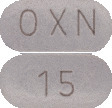

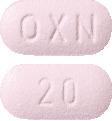
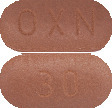
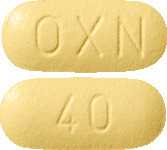
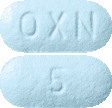
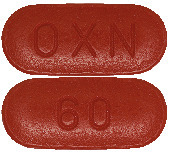
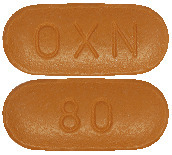
 It is emphasised that this is a guide to the required dose of Targin modified release tablets only. Inter-patient variability requires that each patient is carefully titrated to the appropriate dose. The correct dosage for any individual patient is the minimum dose that controls the pain, provides functional improvement and is well tolerated, for a full 12 hours. Patients should be titrated to pain relief and functional improvement unless unmanageable adverse drug reactions prevent this.
It is emphasised that this is a guide to the required dose of Targin modified release tablets only. Inter-patient variability requires that each patient is carefully titrated to the appropriate dose. The correct dosage for any individual patient is the minimum dose that controls the pain, provides functional improvement and is well tolerated, for a full 12 hours. Patients should be titrated to pain relief and functional improvement unless unmanageable adverse drug reactions prevent this.

 Adverse drug reactions attributable to Targin modified release tablets were reported at the frequencies below:
Adverse drug reactions attributable to Targin modified release tablets were reported at the frequencies below:


 The results show a clinically relevant and statistically significant improvement of the BFI scores in the Targin group compared to oxycodone CR tablets. The improvements consistently appeared in the Full Analysis (FA) as well as the Per Protocol (PP) population, in all the subgroups, in sensitivity analysis with Last Observation Carried Forward (LOCF) imputation, and in all 3 single BFI parameters. See Table 9.
The results show a clinically relevant and statistically significant improvement of the BFI scores in the Targin group compared to oxycodone CR tablets. The improvements consistently appeared in the Full Analysis (FA) as well as the Per Protocol (PP) population, in all the subgroups, in sensitivity analysis with Last Observation Carried Forward (LOCF) imputation, and in all 3 single BFI parameters. See Table 9. In the FA population at week 1 the mean BFI decreased by -28.3 in the Targin group and by -13.1 in the oxycodone CR tablets group. A median decrease of -23.3 in the Targin group compared with -6.7 in the oxycodone CR tablets group was observed.
In the FA population at week 1 the mean BFI decreased by -28.3 in the Targin group and by -13.1 in the oxycodone CR tablets group. A median decrease of -23.3 in the Targin group compared with -6.7 in the oxycodone CR tablets group was observed.
 The structural formula for naloxone hydrochloride dihydrate is:
The structural formula for naloxone hydrochloride dihydrate is:
